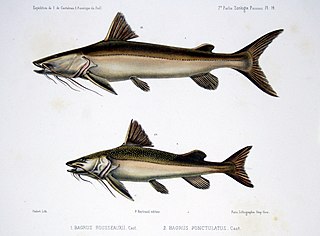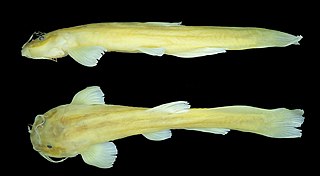
Trichomycteridae is a family of catfishes commonly known as pencil catfishes or parasitic catfishes. This family includes the candiru fish, feared by some people for its alleged habit of entering into the urethra of humans. They are one of the few parasitic chordates. Another species is the life monsefuano which was important to the Moche culture and still an important part of Peruvian cuisine.
Listrura is a genus of pencil catfishes native to South America.

Phreatobius is a genus of very small catfishes from tropical South America.

Brachyplatystoma is a genus of catfish from the family Pimelodidae. As the occasionally used common name goliath catfishes indicates, this genus includes some of the largest species of catfish, including the piraíba, B. filamentosum, which reaches up to the region of 3.6 metres (12 ft) in length. Brachyplatystoma are found in the Amazon and Orinoco basins, and other tropical freshwater and brackish habitats in South America. Some species are migratory. These fish are important as food fish and, to some extent, aquarium fish.
Lithogenes is a genus of South American catfish of the family Loricariidae. It is the only genus within the subfamily Lithogeneinae.

Pseudopimelodus is a genus of catfishes of the family Pseudopimelodidae.
Duopalatinus is a small genus of long-whiskered catfishes native to South America.

Platysilurus is a genus of long-whiskered catfishes native to South America.
Glaphyropoma is a genus of small pencil catfishes native to Bahia in Brazil.
Malacoglanis gelatinosus is a species of catfish of the family Trichomycteridae, and the only species of the genus Malacoglanis. This fish grows to about 2.0 centimetres (.79 in) SL. and is native to the Caquetá River basin of Colombia. Stauroglanis is the sister group to a monophyletic group formed by Malacoglanis and Sarcoglanis.
Sarcoglanis simplex is a species of catfish of the family Trichomycteridae, and the only species of the genus Sarcoglanis. This fish originates from the upper Rio Negro basin of Brazil. Stauroglanis is the sister group to a monophyletic group formed by Malacoglanis and Sarcoglanis.
Tridensimilis is a genus of pencil catfishes native to South America.

Copionodon is a genus of catfishes of the family Trichomycteridae. It includes three species, C. lianae, C. orthiocarinatus, and C. pecten.
Ammoglanis is a genus of pencil catfishes native to South America.

Helogenes is a genus of whale catfish found in tropical South America.
Pseudostegophilus is a genus of pencil catfishes native to rivers in tropical South America. The members of this genus are obligate parasites that feed on scales and mucus of other fish.
Stegophilus is a genus of pencil catfishes native to South America.
Pygidianops is a genus of pencil catfishes native to South America.
Typhlobelus is a genus of pencil catfishes native to South America.
Ochmacanthus is a genus of pencil catfishes native to South America. These species are distributed in South America. O. alternus and O. orinoco originate from the Rio Negro and Orinoco River basins of Brazil and Venezuela. O. batrachstoma inhabits the Paraguay River basin in Brazil. O. flabelliferus lives in river drainages in Guyana and Venezuela. O. reinhardtii is known from the Amazon River basin in Brazil and drainages in French Guiana.






